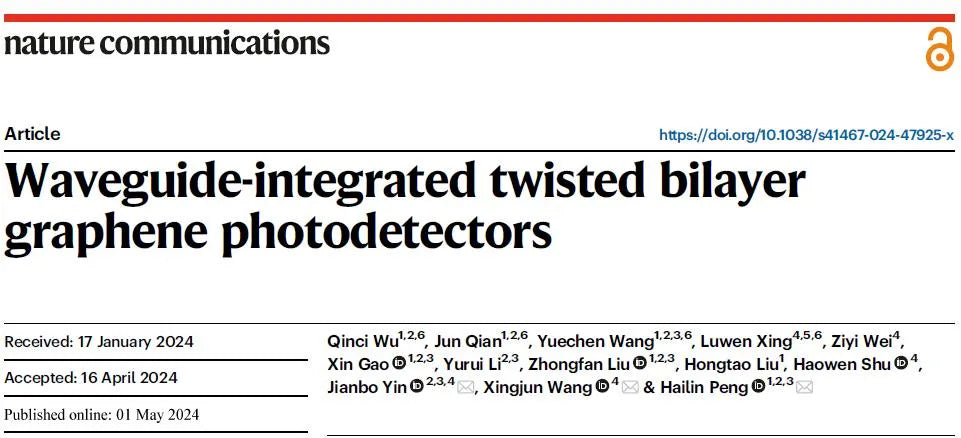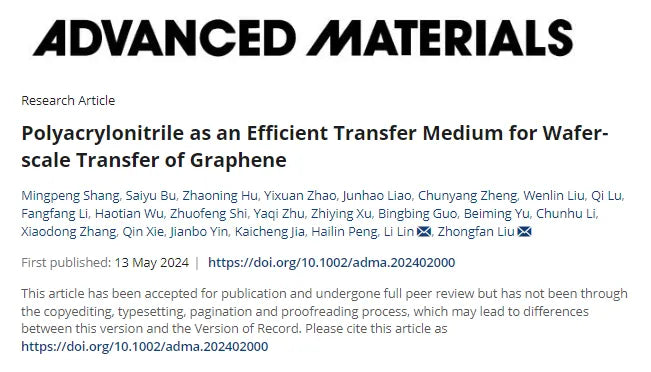In the era of 5G communication and the Internet of Things (IoT), data traffic is growing exponentially, raising demands for reduced energy consumption, increased bandwidth, and lower costs in optical communication. Silicon photonics technology, which integrates optical signal transmission, data modulation, and processing on a single chip, offers higher integration, lower power consumption, and cost-effectiveness. However, the performance of silicon photonic devices is limited by the materials used, such as silicon and germanium, due to their bandgap and mobility restrictions. As a result, finding materials and device structures compatible with silicon photonics that can overcome these limitations is a current research focus.
Graphene stands out as a promising candidate for integration with silicon photonic chips due to its unique advantages: it has no dangling bonds, avoiding lattice mismatch and interface charge scattering when integrated with silicon wafers, and it has a high carrier mobility, allowing for high bandwidth limits. Additionally, graphene can be directly transferred onto silicon photonic substrates and is compatible with silicon-based micro-nano processing technologies, meeting the requirements for device miniaturization and high-density integration. However, monolayer graphene's low optical absorption has resulted in low responsivity in current graphene photodetectors, limiting its use in high-performance optical communication systems.
Research Breakthrough
To address these challenges, BGI, in collaboration with the research groups of Prof. Peng Hailin and Prof. Yin Jianbo at Peking University's College of Chemistry and Molecular Engineering, along with Prof. Wang Xingjun from Peking University's School of Electronics, has successfully developed a waveguide-integrated twisted bilayer graphene (tBLG) photodetector. This new device achieves both high responsivity and high bandwidth. The study, titled Waveguide-integrated twisted bilayer graphene photodetectors, was published on May 1, 2024, in Nature Communications (Nature Commun. 2024, 15, 3688).
In recent years, Prof. Peng's research group has focused on the physical chemistry of two-dimensional materials and nanodevices, achieving breakthroughs in the synthesis of high-mobility 2D materials like graphene, topological insulators, and transition metal dichalcogenides. The group has pioneered the growth of 4-inch ultra-flat single-crystal graphene wafers and scalable production (ACS Nano 2017, Science Bull. 2019), as well as the growth of high-quality twisted bilayer graphene (Nat. Commun. 2021). They have also developed optoelectronic devices based on twisted bilayer graphene and large-area thermal electron-emission devices integrated with ultra-flat single-crystal graphene wafers (Nat. Commun. 2022).
In this latest study, the researchers integrated tBLG with silicon photonics by designing the twist angle to match the van Hove singularity (vHs) in the tBLG band structure with the photon energy at the 1,550 nm communication wavelength. This significantly enhances the coupling efficiency with light. Furthermore, the linear dispersion near the Dirac point in the tBLG band structure ensures ultra-high carrier mobility, comparable to monolayer graphene, guaranteeing excellent high-frequency performance.
Simulations have shown that tBLG can improve coupling efficiency by about three times compared to monolayer graphene, effectively shortening the channel length and enhancing responsivity.

Device Performance
The research demonstrates that when the twist angle of tBLG is 4.1°, the energy difference between the vHs and the Dirac point is 0.4 eV, which is half the photon energy of 1,550 nm (0.8 eV), achieving the highest light coupling efficiency. The device design enables a responsivity of up to 0.65 A/W with a device length of just 8 μm. Multiple devices show an average responsivity of 0.54 A/W, significantly better than monolayer or AB-stacked bilayer graphene devices.
In addition to its high responsivity, the graphene-silicon photonic device also features a high bandwidth, with a 3 dB bandwidth of up to 65 GHz (limited by measurement equipment). The device showed a clear eye diagram at 50 Gbit/s modulation, with a power consumption as low as 0.8 pJ/bit, demonstrating its potential for optical communication applications.
The study further validated the feasibility of integrating large-area tBLG with silicon photonics. Using controlled stacked film transfer technology, the researchers fabricated waveguide-integrated tBLG photodetector arrays, showing a high bandwidth of 36 ± 2 GHz and a high responsivity of 0.46 ± 0.07 A/W, with excellent uniformity, demonstrating the potential for large-scale integration of tBLG in high-performance optical communication devices.

Conclusion and Outlook
This research represents the first successful fabrication of a photodetector integrating twisted bilayer graphene with silicon waveguides, combining the unique vHs band structure of tBLG with innovative device design. The result is a high responsivity of 0.65 A/W and a 3 dB bandwidth of 65 GHz (limited by measurement equipment). The fabrication of large-area tBLG device arrays, with verified high responsivity (0.46 ± 0.07 A/W) and high bandwidth (36 ± 2 GHz), further demonstrates the potential of integrating tBLG with silicon photonics for large-scale production of high-performance optical communication devices. The development of wafer-scale tBLG growth and transfer technologies adds to the significance of this work.
Prof. Peng Hailin, Prof. Wang Xingjun, and Prof. Yin Jianbo are corresponding authors of the paper. The study's co-first authors are doctoral student Wu Qinci, postdoctoral researcher Qian Jun, and doctoral student Wang Yuechen from BGI and Peking University, along with graduate student Xing Luwen from Prof. Wang Xingjun's group at the School of Electronics. Other key contributors include Prof. Liu Zhongfan, Prof. Shu Haowen, and Associate Researcher Liu Hongtao. This work was supported by the Ministry of Science and Technology, the National Natural Science Foundation of China, the Beijing National Research Center for Molecular Sciences, and the New Cornerstone Science Foundation, with additional support from Peking University's Molecular Materials and Nanoscale Fabrication Laboratory and the State Key Laboratory of Regional Optical Fiber Communication Networks and New Optical Communication Systems.
Paper link: https://www.nature.com/articles/s41467-024-47925-x





Leave a comment
All comments are moderated before being published.
This site is protected by hCaptcha and the hCaptcha Privacy Policy and Terms of Service apply.